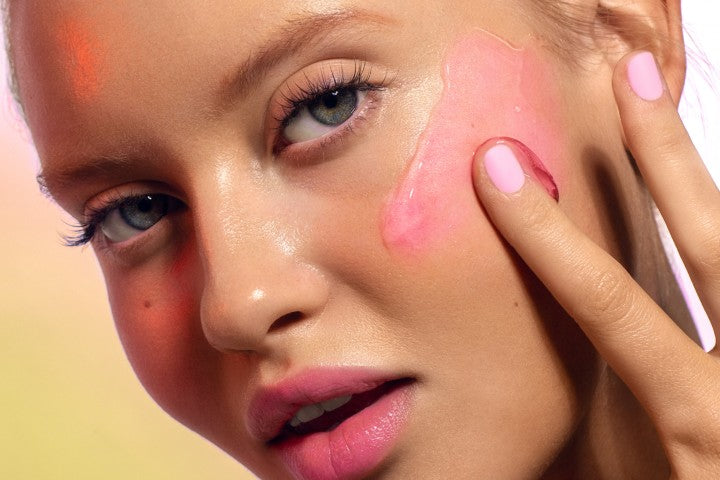Can You Use Lactic Acid and Retinol Together?

Look at the back of any skincare product, and you should see a list of different chemicals with complicated names. What are they and what do they do? Are they safe to use? It can definitely leave you feeling baffled. Things get all the more confusing when you’re trying to treat various skin concerns using more than one serum. How do you know which ones you can use together, and which ones you can’t?
In this article, we’re going to discuss how safe it is to combine lactic acid and retinol. Both popular skincare ingredients, we’ll be breaking down what each one is and does, and whether they work well together.
WHAT IS LACTIC ACID?
Lactic acid is an alpha hydroxy acid (AHA) that gently exfoliates the skin. Other popular AHAs include glycolic acid and mandelic acid. However, the derms say lactic is the gentlest AHA available, and well-tolerated by all skin types including sensitive skin.
Lactic acid is a chemical exfoliant that works by sweeping away dead skin cells, ultimately improving skin tone, skin texture, and reducing the appearance of fine lines. It can also prevent the formation of breakouts by keeping pores clear and also fade acne scarring, dark spots, and hyperpigmentation.
You’ll find lactic acid in a slew of skincare products ranging from cleansers to serums and lotions.
WHAT IS RETINOL?
Retinol is a powerful anti-aging ingredient commonly found in serums, toners, and creams. Research has shown that retinol can increase collagen production, restore elasticity, and speed skin cell turnover, which all help in delaying signs of aging. This vitamin A derivative can also be helpful for acne-prone skin.
The only downside to retinol is that it can come with a few unpleasant side effects such as dryness, skin irritation, and flaking. It’s not ideal for dry skin and sensitive skin as it can be too potent. That said, taking a few precautions like starting slow and with a low concentration can help prevent irritation from occurring.
IS IT SAFE TO COMBINE LACTIC ACID AND RETINOL?
Lactic acid and retinol are both powerful active ingredients that offer a range of skincare benefits. When it comes to the topic of pairing retinol together with lactic acid, or other AHAs, opinions are divided. Some dermatologists, however, insist that it’s totally fine to use retinol with lactic acid and even BHAs like salicylic acid.
Some Say Yes
“It's a myth that retinols cannot be used with exfoliating acids, AHAs and BHAs, because they both exfoliate the skin,” says Daniel Isaacs, Formulation & Development Director at Medik8.
He says it might even be beneficial to pair the two since they work on different levels within the skin.
“Retinols stimulate cellular renewal to produce new skin cells, while AHAs slough off the top layer of skin cells to reveal fresh ones beneath,” says Issacs. “They can actually work in conjunction to promote a healthy, even skin tone and texture.”
Some Say No
Others disagree.
"I definitely wouldn’t apply an alpha hydroxy acid, like glycolic acid, and retinol at the same time," says London-based consultant dermatologist, Dr. Justine Kluk. "The reason is because both of these carry a high risk of irritant contact dermatitis, characterised by redness, peeling and sensitivity.” Used together in the same skincare routine, your chances of skin sensitivity increase — according to Kluk.
So what’s the right answer? To mix or not to mix? If you have oily skin, acne-prone skin, or mature skin, you could possibly benefit from pairing both ingredients together. Those with sensitive or dry skin, on the other hand, should probably stick to using one or the other to prevent skin irritation and increased dryness.
WHAT ABOUT BHA AND RETINOIDS?
If you’re looking to treat and prevent acne, the best ingredient is salicylic acid — a beta hydroxy acid (BHA) that unclogs pores and fights acne-causing bacteria. Since retinols can also be effective at speeding cell turnover and keeping pores clear, they can be even more effective when used in the same skincare regimen.
On that note, be especially careful if you have dry or sensitive skin as both individual ingredients can be drying and irritating. Always use with care, and refrain from using if you experience side effects such as dryness, redness, irritation, or flaking.
SHOP SKINCARE PRODUCTS WITH LACTIC ACID
Tighten Mask
A glossy jelly mask of red microalgae and alpha hydroxy acids, such as glycolic and lactic acid to firm up sagging skin, minimize the appearance of fine lines and wrinkles, and visibly brighten skin. While red microalgae lends its antioxidant properties, its AHAs help buff away dead cells from the skin’s surface to brighten, smooth, and tighten skin. This formula also contains aloe and glycerin to hydrate skin and drive dryness out. Plus, it’s designed for both the face and body — so apply wherever your skin needs extra attention! Remember to apply sunscreen after application.
Tighten Serum
Same product — in serum form. Tighten Serum is a plant-based anti-aging elixir that lifts, smooths, and restores elasticity for bouncy, youthful skin. Red microalgae and lactic acid work in tandem to gently sweep away dead skin cells and protect against oxidative stress to address visible signs of aging while delivering firmer, glowier skin. Remember to apply SPF after applying to prevent sun damage.
Lactic acid and retinol are both high-performance skincare ingredients that are definitely worth including in your skincare routine. While opinions differ when it comes to the safety of pairing them together, it’s worth making a decision based on your skin type. If your skin adjusts easily to products, try pairing them. If your skin is super sensitive or severely dry, stick to using one of them — and sparingly.
You can also pair lactic acid with hyaluronic acid and niacinamide. Avoid pairing it with vitamin C, which can be a highly unstable ingredient. Even if it doesn’t trigger irritation, the two ingredients may make each other less effective when used together.
Most important of all, pay attention to your skin — and listen to what it’s telling (or showing!) you!
